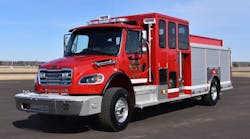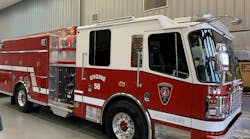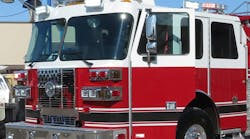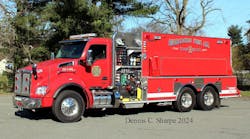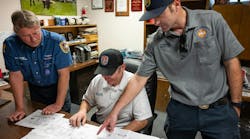Much has been done to improve firefighter safety. Nowhere is that more evident than in the design and manufacture of modern fire apparatus.
Improvements have also been made in the road-to-pump gear shift, but has enough been done? Consider the documentation of the line-of-duty deaths of two firefighters in 1998, as reported by the National Fire Protection Association (NFPA).
In the first incident, the victim was in front of a pumper, operating the pump controls to fill a portable folding water tank. When he advanced the throttle, the apparatus moved forward, pinning him between the pumper and the tank. The tank then collapsed, and the pumper ran over him. In the second incident, the victim was run over as he and several firefighters and bystanders tried to get out of the way of a pumper that began to move when the throttle at the pump panel was advanced. Investigators could not determine the position in which the pump transfer control switch had been set.
Those are not isolated incidents. In upstate New York several years ago, a pumper was parked behind a ladder truck, and the pumper was said to have been switched to pump gear. As a firefighter was taking a portable ladder from the rear of the ladder truck, the pump operator at the pump panel was beginning to advance the throttle. The pumper lunged forward, pinning the firefighter between the pumper and the ladder. The firefighter suffered severe crushing injuries and died a month later.
In my career in the New York City Fire Department I had the privilege of serving for about a year in the Safety Battalion, where one of the many duties was to investigate safety-related issues. One of those issues was reports of pumpers moving after they were put into pump gear. Many observers believed, and conventional wisdom taught, that even if the pump shift is not engaged and the apparatus is in pump, the vehicle's maxi-brake would stop and hold the vehicle.
The Safety Battalion did some testing, using new pumpers that had not yet been put in service. The apparatus were driven to a large limited-access parking lot. We assigned two safety personnel to each pumper - one inside the cab and the other at the pump panel. We then told the person in the cab to engage the maxi-brake and put the apparatus in drive, purposely eliminating the road to pump step, and to be prepared to operate the service brakes in case the maxi-brake did not hold. Then we instructed the person at the pump panel to slowly advance the throttle, duplicating the actions that would occur had the apparatus been placed into pump gear. We also instructed all personnel to monitor the engine's rpm gauge as the throttle at the pump panel was advanced. At 1,600 rpm the apparatus overrode the maxi-brakes and lunged forward.
We placed a telephone call to the manufacturer of the brakes. We reported to an engineer what had just occurred, but he replied that what had just happened was impossible, that the brakes must be out of adjustment or that there must be another problem. We explained that the apparatus were brand new and had not been put into service. The engineer agreed to go to the testing site the following day and perform a full inspection of the brakes. He did so, then we ran the tests again with the same results.
Being alarmed by the test results and having access to my volunteer fire department's pumpers and those of neighboring departments, we expanded the testing to include other apparatus manufacturers and other brake manufacturers, along with a variety of fire pump manufacturers. The testing showed that all of the pumpers tested, regardless of the manufacturer of the vehicles or the components, overrode the maxi-brakes at between 1,300 and 1,800 rpm.
There are lessons to be learned from this experience. First, pump operators must be properly training and certified, then re-certified every year. Couple that with the mandatory use of the NFPA-compliant wheel chocks every time a vehicle comes to a stop outside the apparatus bay, whether it is being put into pump or not.
A big-city rescue company was responding to a call in a rescue truck that was less than a year old. The truck is state of art, with an electromagnetic auxiliary brake retarder and an NFPA electric load shedder/electrical management system. During the response, the load shedder shed the electromagnetic retarder. Now, the only way to stop the 72,400-pound rescue truck was via the service brakes. The service brakes did bring the truck to a stop, narrowly missing a civilian vehicle.
A telephone call was placed to the manufacturer, which in turn contacted the vendors that had supplied some of the components. Their consensus was that it was impossible for the load shedder to shed the retarder. But it did. After several weeks, with the rescue out of service, it was determined that an electronic signal jumped from one wire into another wire that was adjacent in a tightly packed loom, sending the false message for the load shedder to shed the auxiliary brake.
The lesson we learned is that while individual vehicle components may be excellent, in combination there may be unintended results.
Michael Wilbur, a Firehouse® contributing editor, is an FDNY lieutenant in Ladder Company 27 in the Bronx and a firefighter in the Howells, NY, Fire Department. He is an adjunct instructor at the New York State Academy of Fire Science and the Orange County Fire Training Center. Wilbur has developed and presented emergency vehicle operator courses throughout the country and has consulted on a variety of fire apparatus issues.


